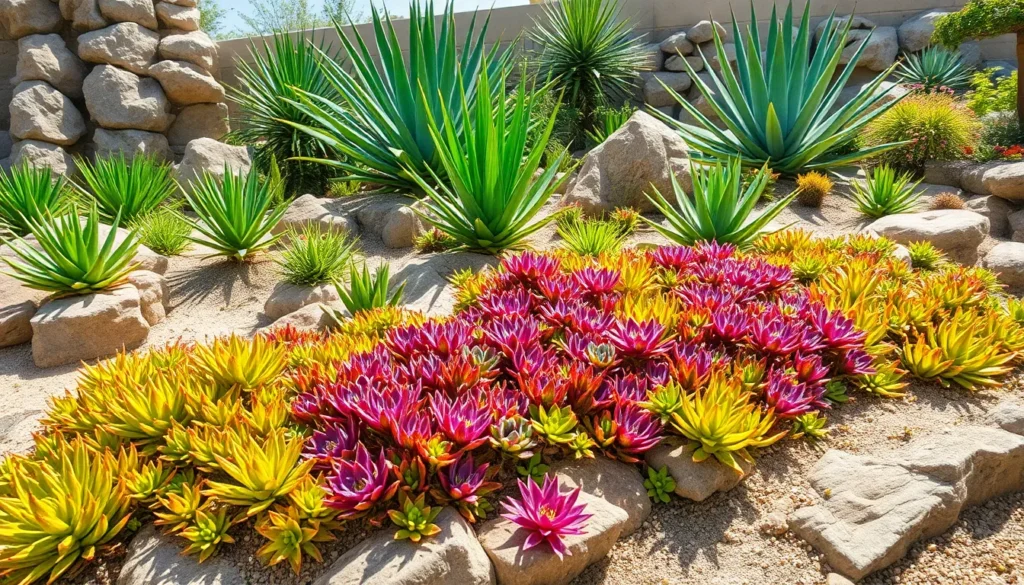Welcome to a world where your garden thrives with minimal effort and water, leaving you more time to savor its beauty. Whether you’re taking your first steps into the gardening realm or you’re a seasoned cultivator, this guide is brimming with practical ideas designed to transform your space into a lush, low-maintenance oasis.
In today’s busy world, finding sustainable gardening solutions that are both efficient and rewarding is more valuable than ever. By exploring these ten low-water landscaping ideas, you’ll not only conserve precious resources but also revel in the satisfaction of a flourishing garden that practically looks after itself.
Imagine the joy of a vibrant garden that stays stunning through the seasons, with plants that are as resilient as they are beautiful. This guide equips you with the knowledge to succeed effortlessly, ensuring your gardening journey is filled with confidence and delight.
Choose Drought-Tolerant Plants
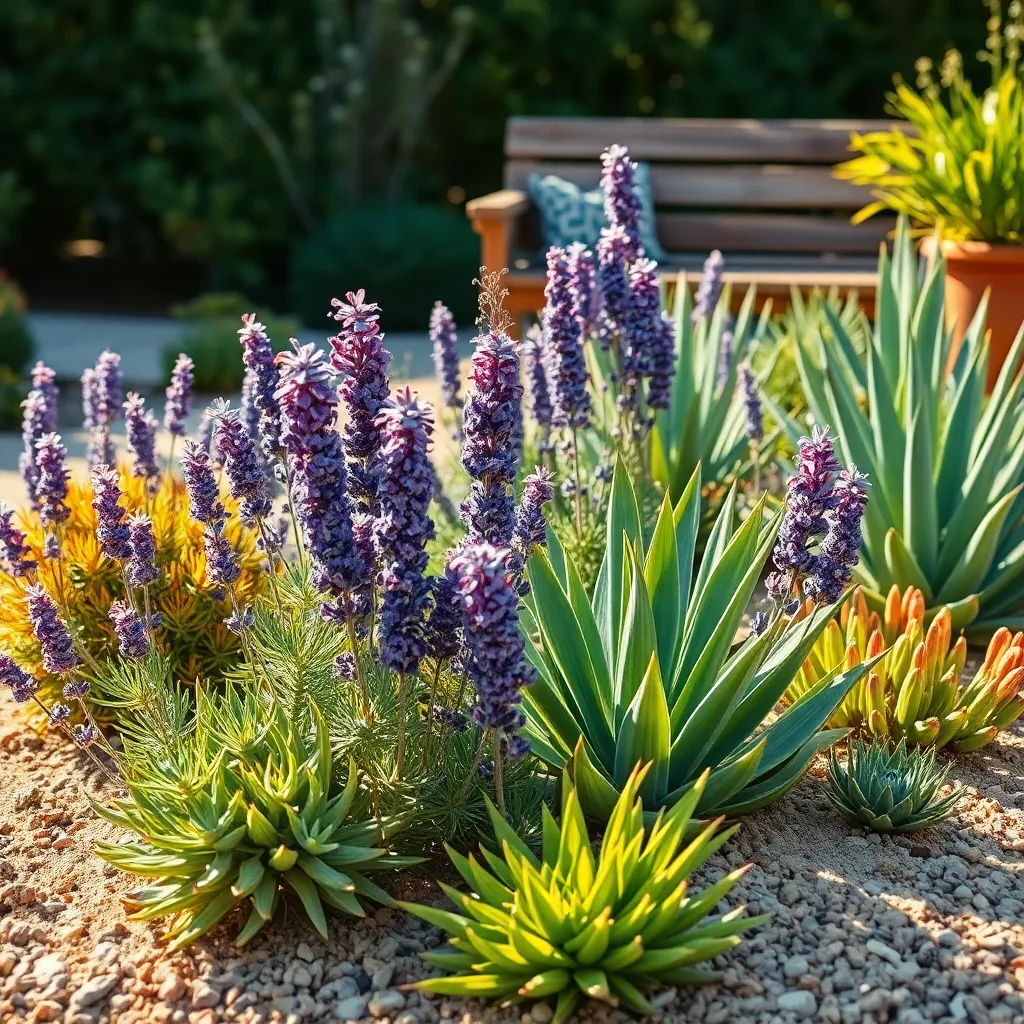
Opting for drought-tolerant plants is a smart way to create a beautiful, low-maintenance garden. These plants typically require less water and are more resilient to dry conditions, making them ideal for water-conscious gardeners.
Consider incorporating succulents like agave and sedum, which thrive in well-drained soil and full sun. For best results, water them sparingly, about once every two weeks, allowing the soil to dry out completely between waterings.
Lavender is another excellent choice, known for its fragrant blooms and ability to withstand drought. Plant lavender in a sunny location with sandy or gravelly soil, and prune it annually to maintain a compact shape and encourage new growth.
Don’t overlook ornamental grasses, such as blue fescue and fountain grass, which add texture while requiring minimal care. These grasses prefer full sun and can tolerate a range of soil types, making them versatile additions to any garden.
Incorporate Gravel and Rock Features
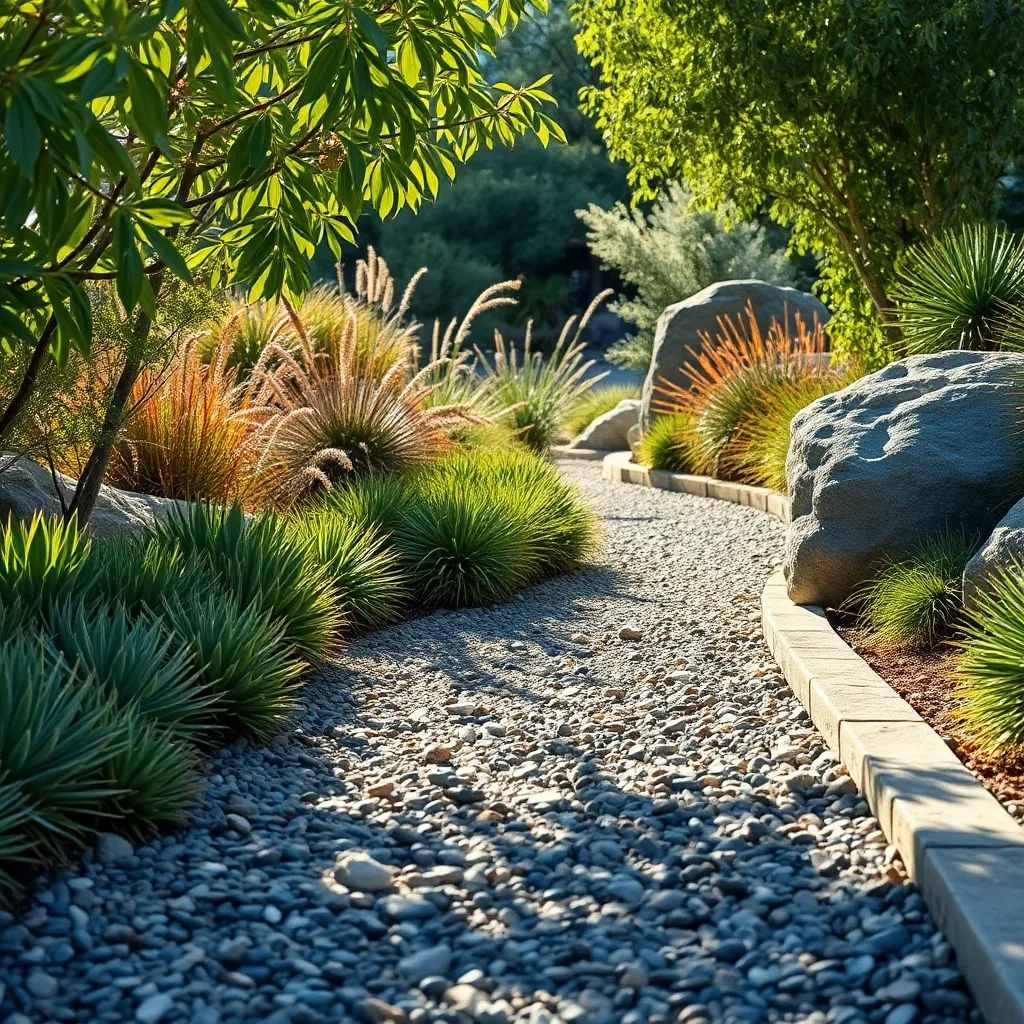
Incorporating gravel and rock features into your garden not only adds a touch of natural beauty but also significantly reduces maintenance. Gravel pathways or rock gardens minimize the need for frequent watering and weeding, making them perfect for low-water landscapes.
Begin by selecting the right type of gravel or rocks to suit your garden’s aesthetic and functional needs. For areas prone to heavy rain, use larger stones and well-draining gravel to prevent erosion and ensure stability.
Consider using gravel as a mulch alternative around your plants to conserve moisture and suppress weeds. This approach reduces water evaporation and keeps your plants hydrated longer, cutting down on watering frequency.
To enhance the visual appeal, incorporate a variety of rock sizes and textures, creating interesting focal points in your garden. For an advanced touch, consider strategically placing rocks to create natural-looking water channels or dry stream beds.
Utilize Mulch to Retain Moisture
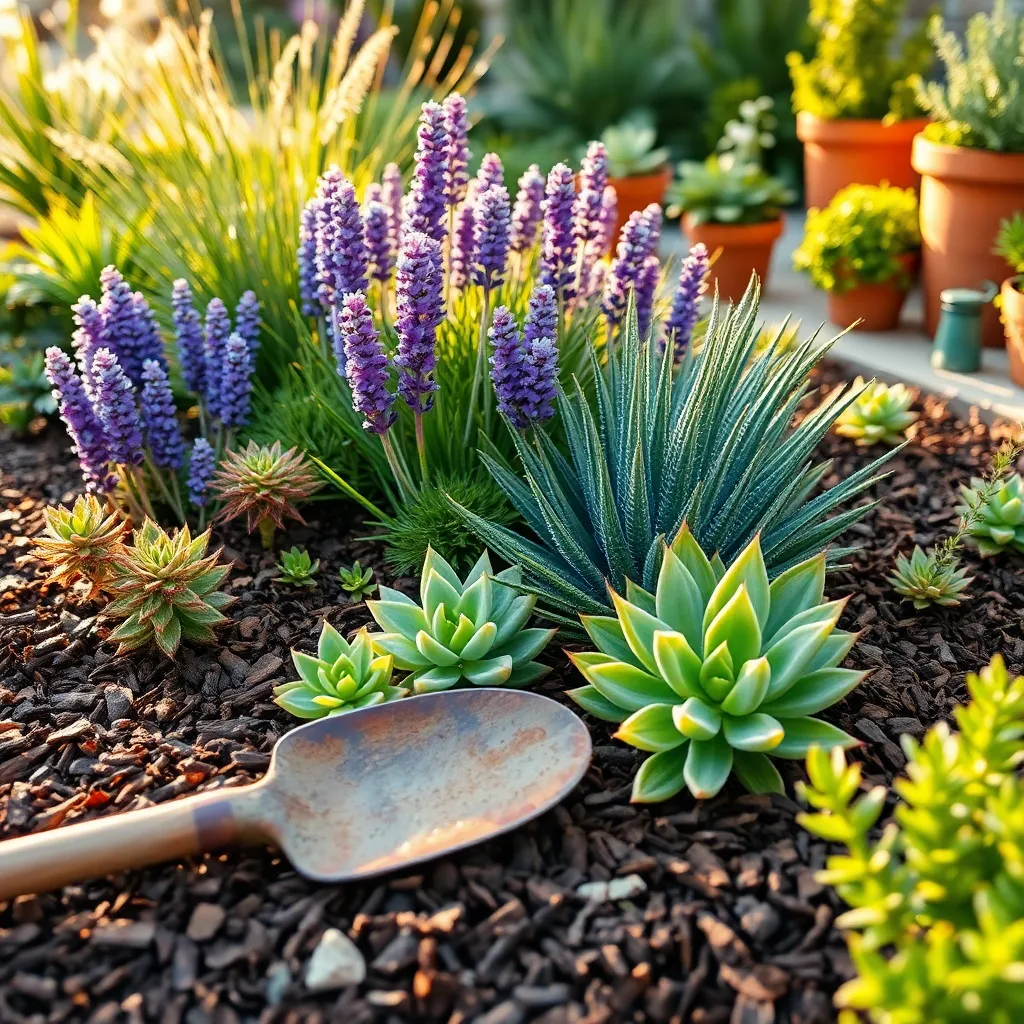
To help retain moisture in your garden, consider using mulch as an effective and low-maintenance solution. By applying a layer of organic or inorganic mulch around your plants, you can significantly reduce water evaporation and keep the soil temperature stable.
Organic mulches, such as shredded bark, straw, or grass clippings, gradually break down and improve soil fertility over time. They are especially beneficial in gardens with plants that thrive in nutrient-rich environments, like vegetables and flowering perennials.
For a more long-lasting solution, inorganic mulches like gravel, pebbles, or landscape fabric can be used. These options are ideal for succulents and drought-tolerant plants, which prefer well-draining soil and less frequent watering.
When applying mulch, aim for a depth of 2 to 4 inches, ensuring it doesn’t touch the stems of your plants to prevent rot. Check the mulch layer regularly, and replenish it as needed to maintain its effectiveness in moisture retention.
Install Drip Irrigation Systems

Installing a drip irrigation system is a fantastic way to ensure your garden gets the right amount of water without wastage. These systems deliver water directly to the roots, significantly reducing evaporation and runoff, which is perfect for low-water landscaping.
To begin, identify the specific areas of your garden that would benefit most from drip irrigation, such as vegetable beds or perennial borders. Measure the spaces accurately to determine how much tubing and how many emitters you will need, ensuring an efficient setup.
Consider using a timer with your system to automate watering schedules, making garden maintenance even easier. Typically, setting the timer to water early in the morning or late in the evening can maximize absorption and minimize evaporation.
For those new to drip irrigation, start with a basic kit that includes all necessary components like tubing, emitters, and connectors. As you become more experienced, you can customize your system by adding components such as pressure regulators or filters to manage water flow more precisely.
Opt for Native Plant Varieties
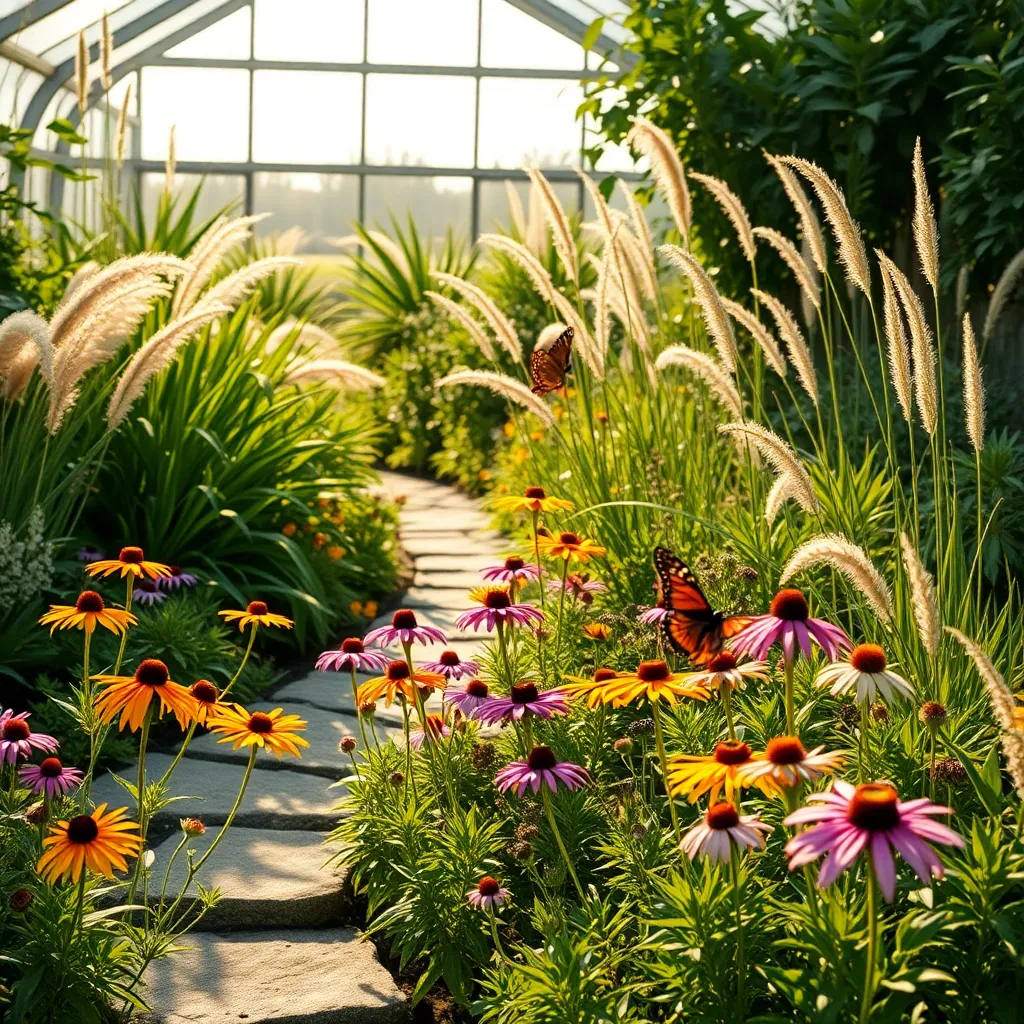
Choosing native plant varieties is a smart strategy for creating a low-maintenance, low-water landscape. Native plants are adapted to the local climate, soil, and pests, which means they generally require less intervention and thrive with minimal care.
Begin by researching plants that are indigenous to your region, as they will be best suited to your garden’s specific conditions. Local nurseries and extension services are excellent resources for identifying these plants and learning about their specific needs.
Soil preparation is crucial for the success of native plants. Most native species prefer well-draining soil, so consider adding organic matter like compost to improve aeration and nutrient content.
Once planted, native varieties often need less frequent watering compared to non-native species. Water deeply but infrequently, allowing the soil to dry out between waterings to encourage deep root growth and drought resilience.
For those looking to add a professional touch, consider grouping plants with similar water and light requirements together. This creates micro-environments that maximize the benefits of native plants and further reduce maintenance needs.
Create Shade with Perennial Shrubs
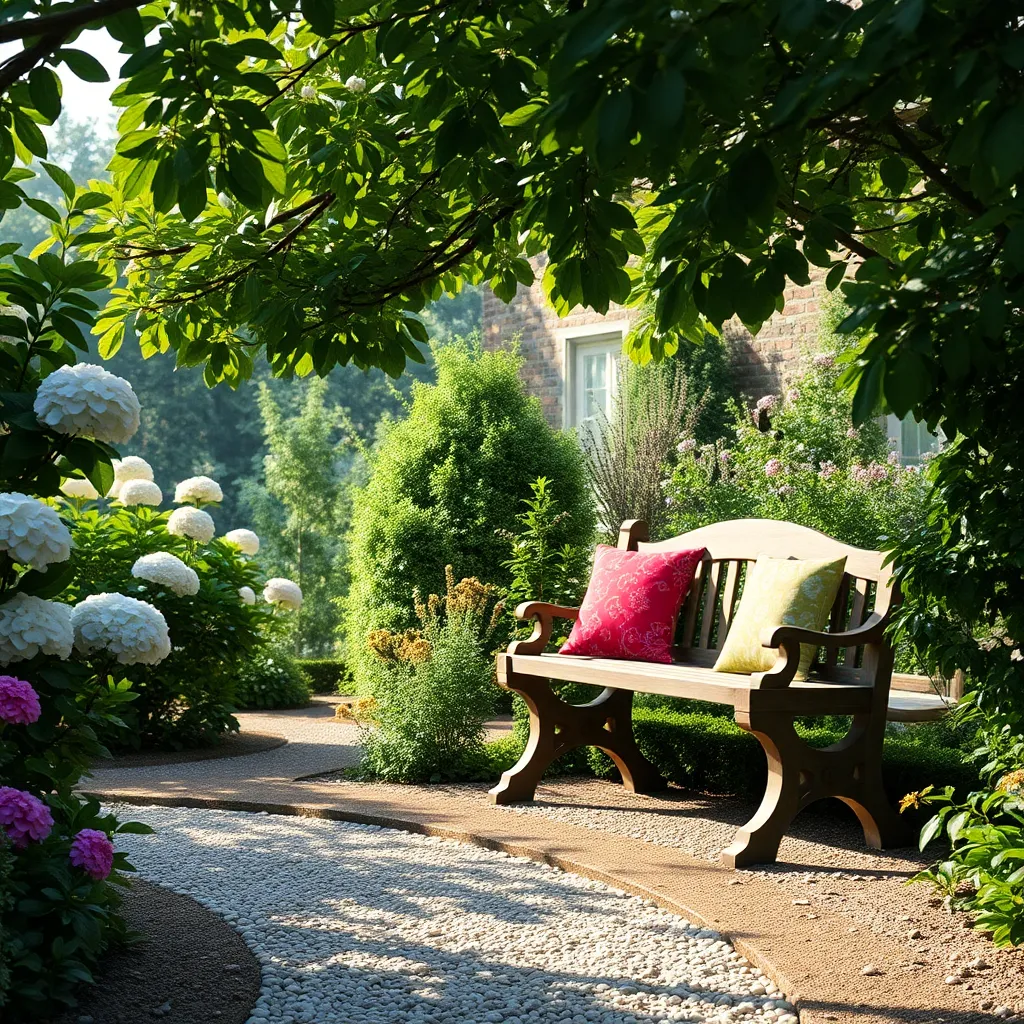
Creating shade with perennial shrubs is an excellent way to establish a cool and inviting landscape while conserving water. Consider planting varieties like Aronia, Viburnum, and Spirea, which are known for their resilience and minimal water needs once established.
Planting these shrubs not only helps in reducing the sun’s direct impact but also provides a habitat for local wildlife. Choose a location with well-draining soil and amend with compost to improve fertility and moisture retention for best results.
When planting, ensure that you space the shrubs adequately to allow for growth and air circulation, which helps in preventing diseases. Water deeply once a week during the first growing season to encourage deep root development, reducing the need for frequent watering later on.
For a more advanced touch, consider pruning the shrubs annually to maintain their shape and promote healthy growth. Mulching around the base of the shrubs is also advisable as it helps retain soil moisture and suppresses weed growth, making garden maintenance even easier.
Design with Water-Wise Groundcovers
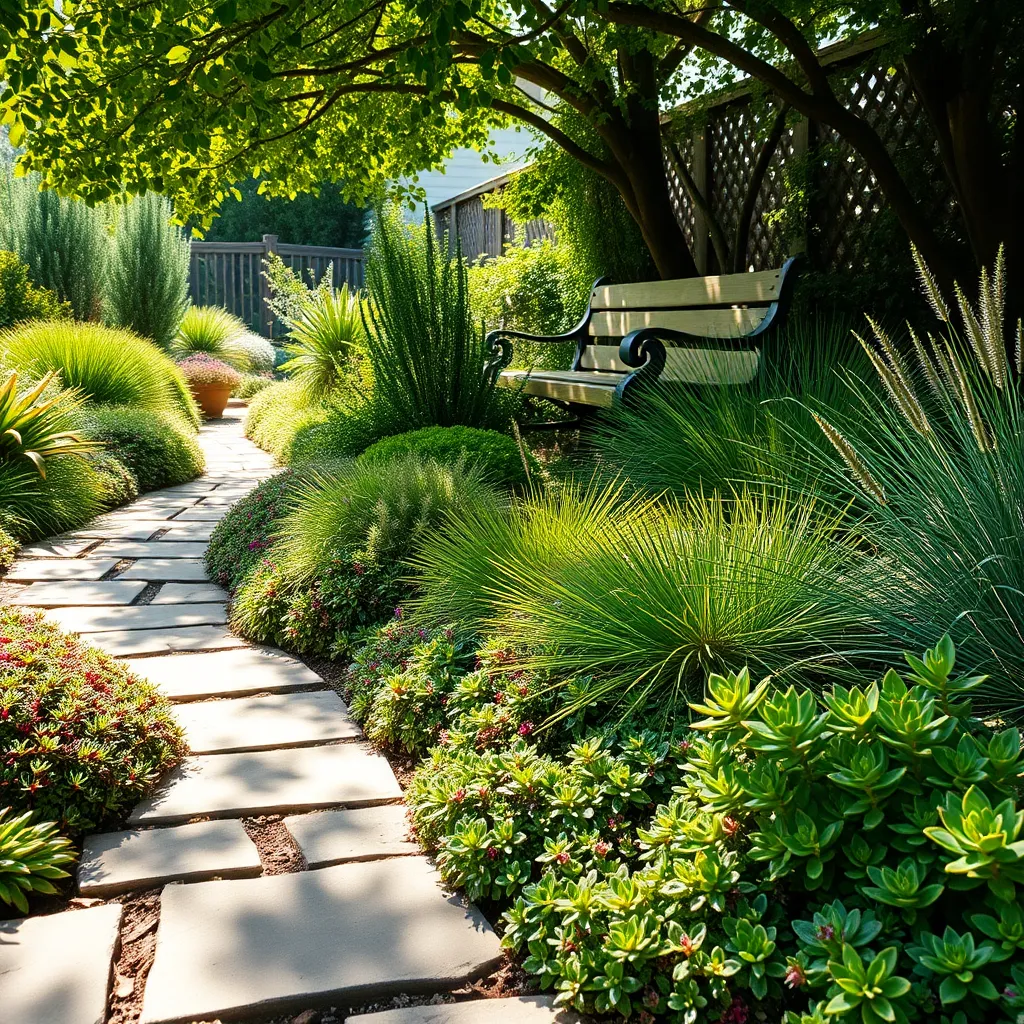
Water-wise groundcovers are an excellent choice for gardeners looking to reduce maintenance while conserving water. These plants can thrive in various conditions, offering a lush carpet of greenery with minimal effort.
Start by selecting groundcovers that are known for their drought tolerance, such as sedum, thyme, or creeping juniper. These plants require little watering once established, making them perfect for dry climates.
To plant groundcovers effectively, ensure the soil is well-draining and amend with organic matter if necessary. Space the plants appropriately, allowing them room to spread, which will help suppress weeds and reduce the need for mulching.
Avoid overwatering by checking the soil moisture before watering; groundcovers typically prefer the soil to dry out between waterings. For an advanced tip, use drip irrigation systems to deliver water directly to the roots, minimizing waste and promoting deep, healthy root systems.
Implement Efficient Watering Schedules
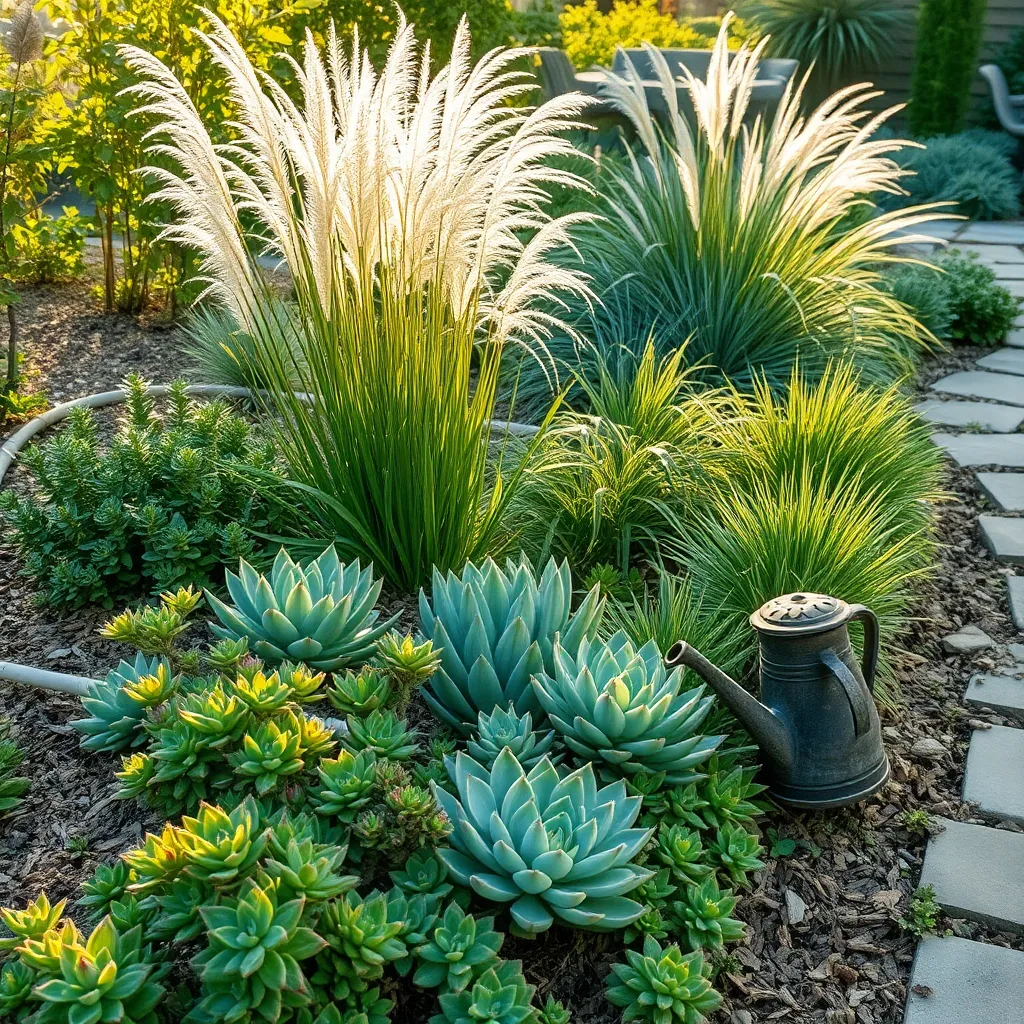
To maintain a low-maintenance garden, establishing an efficient watering schedule is essential. Watering in the early morning allows moisture to seep into the soil without being lost to evaporation, ensuring that plants receive the hydration they need.
Beginner gardeners should start by assessing the specific water needs of their plants, as different species have varied requirements. For instance, succulents and cacti require infrequent watering, while other drought-tolerant plants might need a weekly soak.
An efficient way to manage watering is through the use of drip irrigation systems, which deliver water directly to the roots. This method not only conserves water but also reduces the growth of weeds by targeting only the plants you want to thrive.
For those looking to enhance their watering efficiency, consider using soaker hoses, which provide a steady, gentle supply of water over a period of time. This technique ensures deep root growth, helping plants become more drought-resistant over time.
Select Low-Water Ornamental Grasses
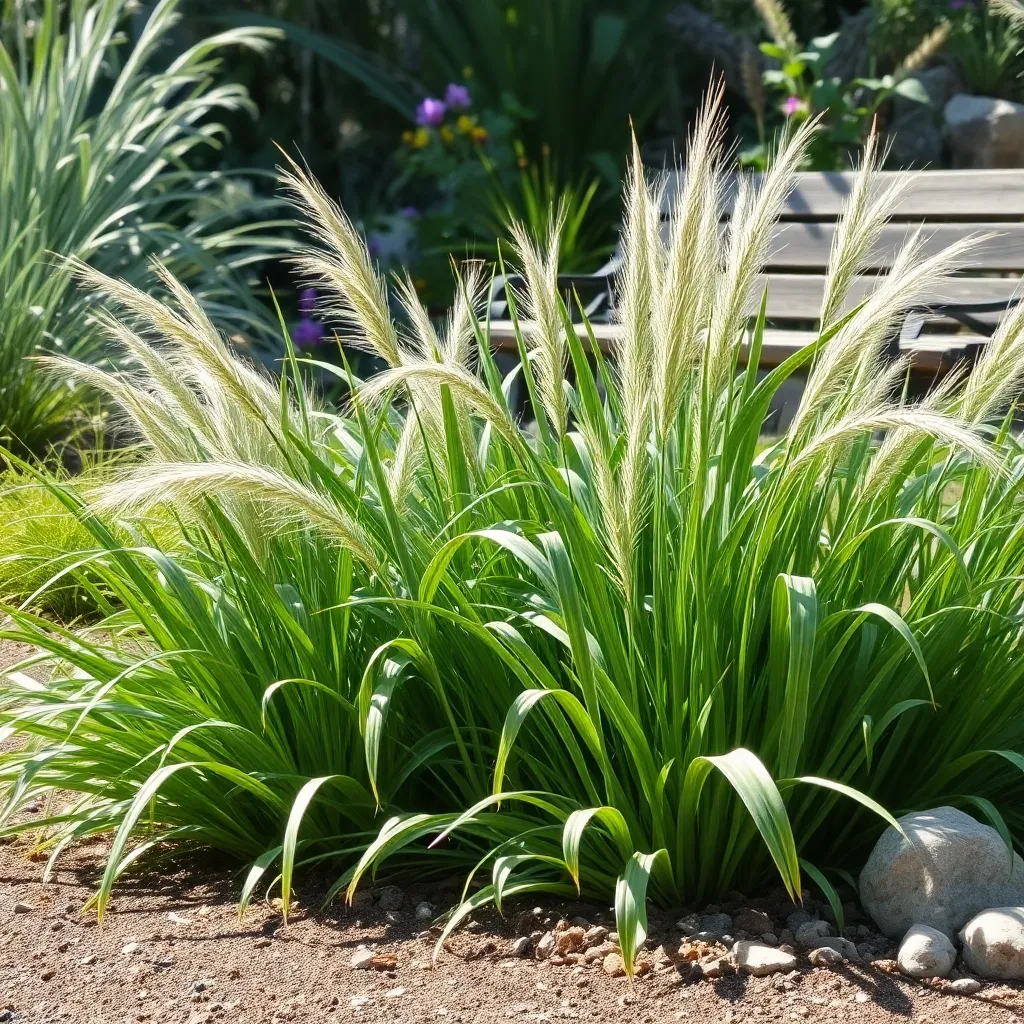
Choosing the right ornamental grasses can significantly reduce water usage in your landscape. Look for drought-tolerant varieties such as Blue Oat Grass, which thrives in well-drained soil and full sun.
Another excellent choice is Feather Reed Grass, known for its upright, feathery plumes and resilience in dry conditions. This grass does well in varied soil types, including clay, making it versatile for many garden settings.
For a bold look, consider the vibrant Red Fountain Grass, which adds color and texture while requiring minimal water. Watering every two weeks during the growing season is usually sufficient to keep it healthy.
To enhance growth and health, regularly remove dead foliage from your ornamental grasses. Pruning in late winter encourages new growth and maintains a tidy appearance.
Integrate Rain Barrels for Irrigation
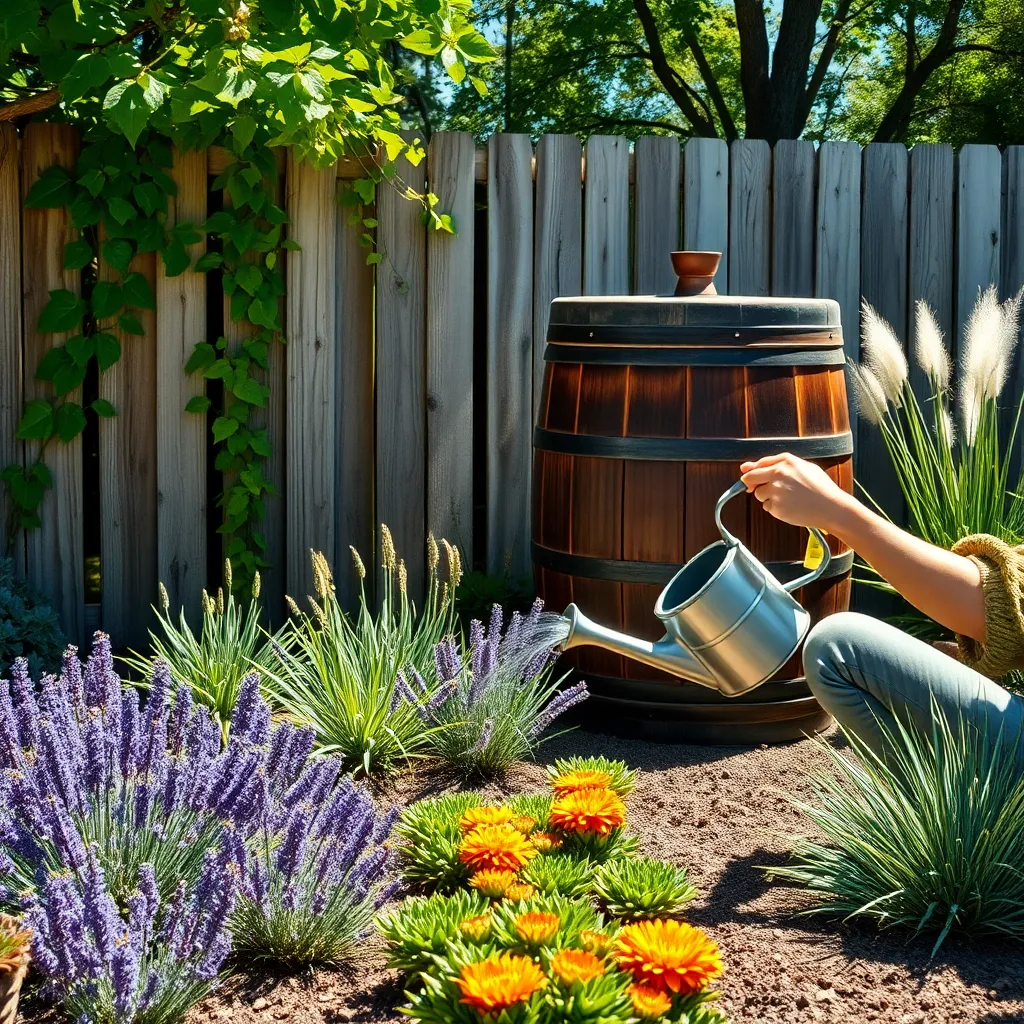
Incorporating rain barrels into your garden is an excellent way to make use of natural resources and minimize water usage. They collect rainwater from your roof, providing a sustainable and cost-effective source of water for your plants.
To start, place your rain barrel under a downspout where it will capture the most water. Ensure the barrel is on a sturdy, elevated surface to create enough pressure for the water to flow through a hose or watering can.
Using the collected water for irrigation helps maintain soil moisture without relying on municipal sources. It’s particularly beneficial for watering during dry spells or for plants needing consistent moisture, like vegetable gardens or newly planted shrubs.
For a more advanced setup, consider installing a drip irrigation system connected to your rain barrel. This can be done using a gravity-fed system, which efficiently delivers water directly to the roots of your plants, reducing evaporation and runoff.
Conclusion: Growing Success with These Plants
In exploring ’10 Low-Maintenance Low Water Landscaping Ideas,’ we uncovered transformative approaches to nurturing relationships that thrive with minimal effort and resources. From embracing the beauty of native plants to the charm of rock gardens, each idea symbolizes a key relationship concept: sustainable growth, resilience, and adaptability. These principles remind us that with thoughtful planning, relationships can flourish without constant demands, just like a well-designed landscape.
As a practical step, choose one idea that resonates most with your relationship goals. Perhaps it’s the simplicity of succulents or the enduring strength of perennial grasses—let it inspire a constructive change in your relationship dynamics today.
Remember, a thriving relationship, like a vibrant garden, is a masterpiece in progress. Bookmark this article as your go-to guide, ensuring that you’re equipped with strategies to cultivate love and understanding in every season.
Looking ahead, envision your relationship as a flourishing garden, rooted in love and watered with intention. With these low-maintenance strategies, you’re not just preserving beauty but fostering a bond that stands the test of time. Save this article now; it’s your roadmap to enduring relationship success.

